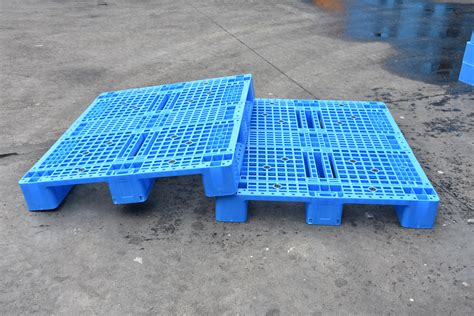How Heavy Are Blue Pallets
Ronan Farrow
Apr 04, 2025 · 3 min read

Table of Contents
How Much Do Blue Pallets Weigh? A Comprehensive Guide
Blue pallets, a common sight in various industries, come in different sizes and materials, significantly impacting their weight. This guide dives deep into understanding the weight variations of blue pallets, helping you estimate their weight based on type and condition.
Factors Affecting the Weight of Blue Pallets
Several factors contribute to the overall weight of a blue pallet:
1. Material: The Foundation of Weight
-
Plastic Pallets: These are generally lighter than their wooden counterparts, typically weighing between 20 and 40 pounds. The specific weight depends on the type of plastic used, the pallet's dimensions, and its design (e.g., solid deck, stringer, or nested). High-density polyethylene (HDPE) is a common material, known for its durability and relatively lighter weight.
-
Wooden Pallets: Wooden pallets, especially those made from hardwood, can be significantly heavier, often weighing between 40 and 60 pounds or even more. The type of wood (e.g., pine, oak), the number of stringers, and the overall construction contribute to the weight difference. Heavier hardwoods naturally increase the overall weight.
2. Size and Dimensions: A Significant Influence
Larger pallets, naturally, weigh more than smaller ones. The dimensions influence the amount of material used, directly impacting the overall weight. While standard sizes exist, variations can lead to differences in weight. Knowing the specific dimensions is crucial for accurate weight estimation.
3. Condition: Wear and Tear Matters
The condition of the pallet significantly affects its weight. Pallets that are damaged, repaired, or have undergone significant wear and tear might weigh differently from new pallets due to repairs, added materials, or loss of material. A severely damaged pallet could be noticeably lighter.
4. Moisture Content: A Hidden Factor
The moisture content of wooden pallets can greatly influence their weight. Pallets exposed to the elements or stored in humid conditions will absorb moisture, leading to an increase in weight. Dry pallets will be lighter than those stored in humid conditions.
Estimating the Weight of Your Blue Pallet
While precise weight determination requires weighing the pallet, you can make a reasonable estimate by considering the factors above.
- Identify the Material: Is it plastic or wood? This is the first key factor.
- Assess the Size: Is it a standard size or larger/smaller?
- Examine the Condition: Is it new, used, or damaged?
- Consider the Environment: Has it been stored in a dry or humid environment?
By carefully considering these points, you can gain a much better understanding of the likely weight range of your blue pallet. Remember, this is an estimation, and actual weight may vary. For precise weight, always weigh the pallet directly.
Conclusion: Understanding the Weight of Blue Pallets is Key
Understanding the factors influencing the weight of blue pallets is crucial for various applications, from logistics and transportation to inventory management and material handling. By understanding the differences in weight based on material, size, condition, and moisture content, you can better plan and manage your operations, ensuring safety and efficiency. Remember to always prioritize safe handling practices regardless of the estimated weight.
Featured Posts
Also read the following articles
| Article Title | Date |
|---|---|
| How Far Can I Move With Joint Custody | Apr 04, 2025 |
| How Do Deer Find Corn | Apr 04, 2025 |
| How Do I Cancel My Burn Boot Camp Membership | Apr 04, 2025 |
| How Do You Shovel A Gravel Driveway | Apr 04, 2025 |
| How Do I Know If My Car Has Electric Brakes | Apr 04, 2025 |
Latest Posts
-
How Is A Night Guard Supposed To Fit
Apr 04, 2025
-
How Is A Lateral Scored In Fantasy Football
Apr 04, 2025
-
How Is A Crown Replaced
Apr 04, 2025
-
How Invisalign Moves Teeth
Apr 04, 2025
-
How I Seduced My Dad
Apr 04, 2025
Thank you for visiting our website which covers about How Heavy Are Blue Pallets . We hope the information provided has been useful to you. Feel free to contact us if you have any questions or need further assistance. See you next time and don't miss to bookmark.
